Recently I had an extremely interesting and enjoyable day at the First Bike on Scene (FBoS) Emergency First Response training course. Like many folk, I’ve attended workplace First Aid training. And as a biker I’ve attended some form of advanced or extra motorcycle training skills, in my case one in France and another in Spain with basic First Aid as part of it.
However, the FBoS training course is on a whole different level, there are no band aids or septic creams in sight on this course.I’d first met Roger and Nick, both FBoS trainers at the Carole Nash Bike Show about 5 years ago and I really liked the idea of a First Aid course specifically aimed at helping an injured biker. However, what I assumed the course would entail and what the course actually provided was quite different. This is definitely not your typical First Aid course, although CPR and Defibrillator training is part of it.
The Course Structure – First Half
The course is split into two sections and trains you as an Emergency First Responder which has a very specific skill set.
The morning started with the first couple of hours of the class with us being brought through the first critical things to do if you are the first person to arrive at the scene of a road collision or road accident. This part involves first learning to secure both yourself and the scene from oncoming traffic, with your own safety being paramount. If you think about it this makes sense as you’ll be no good to anyone if you become injured yourself as you’ll end up just making the whole situation worse.
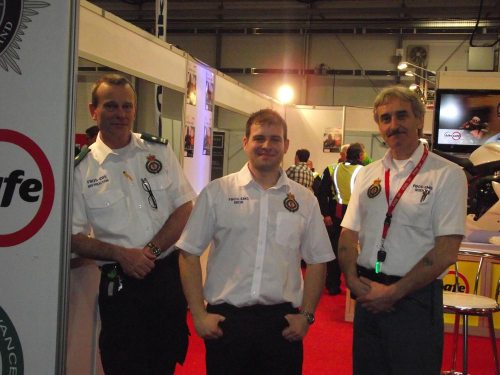
Nick, Ricky and Rodge at the Belfast Bike Show. A joint venture with the PSNI BikeSafe Team and Institute of Advanced Motorists.
After that it’s into gathering as much information as possible, then contacting and providing the relevant information to the emergency services. You might be forgiven for thinking this is easy or straightforward and in fact common sense. This is not necessarily the case, not by a long shot, and certainly not in a multi vehicle/victim situation. At this, and each consecutive stage of an incident we are given a clear set of rules to run through to manage ourselves throughout the situation. Basically this is accident scene management, knowing how to do this keeps you focused and well placed to efficiently work the site to get you to the side of the injured parties who need you most. Knowing the rules removes indecision “the headless chicken” and helps you to not become a danger to yourself and others.
I am not going to describe any of this in too much detail as this is not a how-to story, but here is the jist of it..
This “might” help get you by at a pinch but does not compare to proper training. There are some very good tips here, so grab yourselves a cuppa and have a good read…
Provided by: Nick at FBoS
Contact email: nick (at) bikerstraining (dot) com
First Bike on Scene: Arriving first on the Scene of an Accident.
What should you do?
- The first priority in any emergency situation is to protect yourself! – Do not put yourself at risk.
- Check for oncoming traffic and consider the speed they might approach at. Do not go by the posted road speed limit; this is often disregarded
- AS A GUIDE – IF THE POSTED SPEED IS 100KPH MULTIPLY BY 3 for the required safe distance to attend a scene = 300 meters.
- An approximate safe distance from the scene may also be judged by making a fist at full arms length, extend your thumb (as for thumbs up sign).
- If the crashed car is obscured by the thumb the distance may be safe.
- A car travelling at 100kph may take over 120 meters to come to a halt!
- Put on a high visibility jacket if you do not routinely wear one when riding.
- Park your bike at the side of the road with hazard lights going if fitted.
- Observe the accident scene from a safe distance. How many vehicles are involved?
- Flag down approaching vehicles without putting yourself at risk, and ask these drivers to take over the task of stopping oncoming traffic.
- Advise these drivers to use ‘viz jackets’ and to keep safe.
- If it is safe to approach the crash scene listen out for running engines – switch of ignitions and remove keys.
- Do not attempt to remove people from the car or move the bike rider!
- Under no circumstances attempt to remove the biker’s helmet – this requires special training – see www.bikerstraining.com
- Ask all occupants to remain still and in the vehicle.
- Note how many are talking/ calling out in pain – these are conscious.
- Note how many are quiet – these may be unconscious.
- Ask the bike rider to remain still.
- Contact emergency services, remain calm. Answer the operator’s questions clearly and remain “on-line” until the operator tells you to hang up.
- As a final “good habit” be always aware of the route especially if the area is not so well known to you. Note obvious landmarks – church, pub, petrol – service station etc. Good to quote to emergency services to help them locate you swiftly.
Studying the Accident Scene Scenarios
Some documentation is provided by the course trainer for you to take home and study yourself, and it’s a good base for you to continually review or to learn more. During the first few hours we are brought through a number of thought provoking accident scene scenarios designed to help us assess the scenes correctly before taking any action. The point of this to firstly protect oneself, i.e. Rescuer Safety First, then others (victims, bystanders) from a long list of potential hazards, i.e. Secure Scene, collect information such as (but NOT limited to) location, number/type of vehicles and casualties involved and what signs to look for that might indicate a pillion was possibly thrown well clear of the scene then supplying the info to 911/999/112.
ACT
- A – Assess (Rescuer Safety First, Secure Scene, Number of Vehicles/Victims
- C – Communicate (112, 999, ETHANE – see below)
- T – Treat (If you want the skills to potentially save a fellow biker do this course, general First Aid may not help)
Under the T for treat comes another acronym – AVPU This is information you need to access of an injured party, both for yourself before you treat, but first to communicate to the emergency services.
- A – Alert
- V – Verbal
- P – Pain
- U – Unconscious
ETHANE – What you need to communicate!
- E – Exact Location
- T – Type of Incident
- H – Hazards
- A – Access
- N – Number/Type of Casualties – AVPU
- E – Emergency Services Required
In each and every one of those points at this stage (except for the Treat part of ACT) a discussion and explanation was brought into play to help us actually understand what all that actually entails when faced with a potentially very stressful scene. I knew of both acronyms before, this and similar are easily available on the internet, however I can not properly express the level of understanding of these points that this course provides.
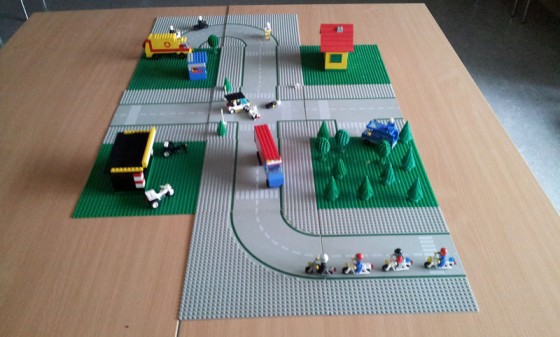
Accident Scene Management Training at FBoS
The classroom environment really helps, for example you can fire any amount of questions at the instructor, but there may be 10 or more other students firing in questions you may not have thought of. So, between the instructor’s presentation and the continual Q&A there is a huge amount of information available for those who attend the course. I’d advise you get a good night’s sleep beforehand as there is going to be a lot of information fired at you.
The Course Structure – Second Half
The second part of the day was an even mix of theory, more Q&A and hands on practice on dealing with most specifically an injured motorcyclist, but also how to deal with an injured car driver. But by far this bit is really about applying Emergency Medical First Response Care to an injured biker and the specific, or most likely injuries he/she will suffer from. This is where the FBoS course is truly unique and provides an invaluable level of training in both theory and practical hands on instruction. We were brought through the types of common injuries a biker may receive, some of this, like broken thigh bones and pelvic injuries caused by handlebars made sense, but something I never heard of or thought of.
Again I am not going into any level of detail on any of what I learned as this is something that absolutely has to be taught under the watchful eye of a qualified instructor. However I can give you something to think about.
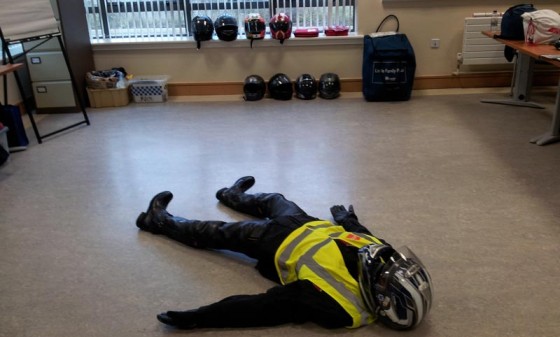
Timmy the training dummy, this poor lad gets awful treatment from students..
This course teaches you to consider all the risk factors and help you to make the decision as to exactly when/if it is necessary to move a victim, and exactly how to do it limiting further injury as much as possible. There is one way to do it correctly – if it must be done at all, and this course teaches it. It’s not something I’d ever been taught before in any other course.
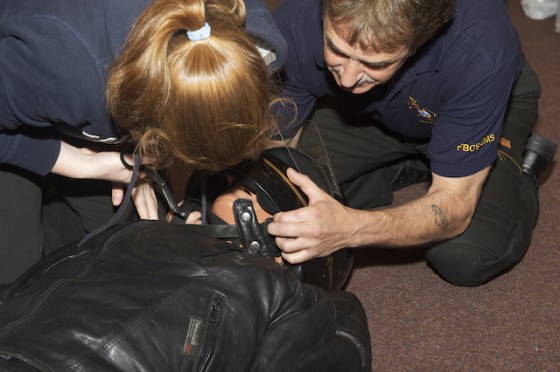
It take a bit of work to be able to remove a helmet properly..
Possibly one of the most important skills this course teaches you exactly when it is not, and when it is necessary to take the helmet off and the specific skill of how to do it limiting the risk of further injury. You’ll have to take my word on this, but it’s not as easy as it seams. DO NOT do anything as profoundly stupid as go looking for a YouTube tutorial on this and thinking you can do it. From my own experience on this course there is absolutely NO WAY I’d ever attempt doing anything so irresponsible without proper, expert instruction AND practicing it over and over again on a fellow attendee and fellow biker under the guidance of a trained instructor with first hand real world experience. Do not think for a second that there is any substitute for attending this course. Doing this course will leave you with more knowledge on how to deal with an injured biker than most police force officers.
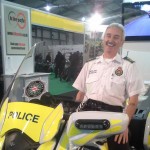
Living proof that a life with motorbikes is good for you. I’ve yet to see Rodge without a big happy smile on his mug..
I will continue to pray to all the Gods (I like to hedge my bets) that I’ll never need or have to make use of the skills and knowledge gained from this course. However, as I’ll always be one of those people who hopes for the best and plans for the worse I am very happy to have done the course.
At least now if I do come upon an incident I will not be one of those useless accident gawkers, instead I’ll confidently ride up and be able to offer enough help to possibly keep someone alive long enough for the professional emergency workers to arrive. That is in fact the whole point of the FBoS course and as far as I am concerned that is exactly what it delivers with the added bonus of being a fun day out with fellow, like minded bikers.
Protective Gear/Armour & Personal Riding Skills
As I mentioned earlier, this course brought to mind some of the typical injuries a motorcyclist receives in a collision. A few of which I’d never considered despite, like most I’m sure, hearing many injury stories. The injuries typically faced by a biker is always thought provoking to me, it would never stop me from riding or doing what I do. I, like all bikers accept the risk, but I do spend a lot of time and money researching and updating my protective gear/armour and personal riding skills.
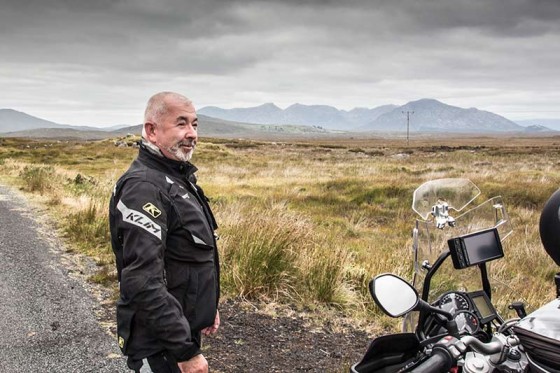
For all weather touring I’m currently a fan of the KLIM gear with L2 armour. However no armour I know of other than a AirBag Vest offers torso internal shock, impact and neck protection all in one.
In the few days after this course I again found myself reevaluating whether or not to invest in a moto air vest and take leg armour a little more seriously. I am without doubt in favour of air vests, what’s stopped me to date is the crippling cost and the infuriating fact that a “luxury tax” is placed on them. This is a fact and conversation that my local canvassing politicians know to avoid having with me at all costs. Anyway, I am now, for myself at least, seriously considering the air vest as a priority that comes in almost as important as a helmet. The FBoS course has only brought this issue back into focus for me.
Calculating the Risks
Should you buy one yourself, how much to spend on a protective item, or even to do this course for that matter? Well I have a formula or two which I personally live by involving financial decisions when it comes to protecting myself, and others while on a motorcycle. Firstly I should explain that I have a fair understanding of working out odds, when to bet, when to fold, and when to hedge my bets. My grandfather was a very successful poker player, as is my wife who works in the poker/gambling industry. I see motorcycling as being very much like a poker game, sometimes you win, sometimes you lose, how badly or how often you lose can depend on how well you work out the odds.
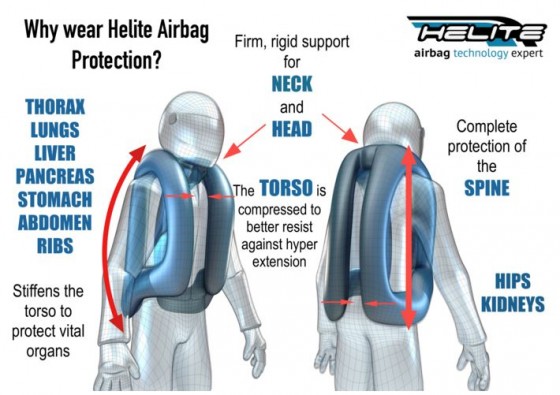
Food for thought..
In this the facts of the game are – the odds of me having an accident “losing” are unarguably higher if there is a risk of black ice so I may choose not to play and leave the bike at home, or I’ll lower my risk by riding much slower, constantly look for signs of ice and wearing the best armour I can afford. If I think about riding on a sunny summer Sunday afternoon I’ll take into account the likely cause of losing, i.e. tired, distracted Sunday drivers, weekend only bikers and/or human error. By taking this into account I’ll lower the risk by riding slower and more defensively, I’ll wear full armour despite the heat, I’ll choose a route/trail avoiding much of the traffic, or I’ll choose not to play and have a BBQ and a few beers in the back garden instead.
When deciding on how much to spend on armour I have a few more simple formulas. The first is simple, buy and use the best I can afford and the most suitable for the predominant application, eg off road/on road armour, leather or cordura. The second again comes down to risk assessment and running the odds. Here the simple fact is that there is an increasing amount of traffic on the road, more traffic leads to more stressed drivers and an increased amount of bad, inattentive or distracted drivers that were never trained properly to account for low profile vehicles like motorbikes. In this there is a new danger element that has crept in in the last 10 years or so, in-car entertainment, i.e. mobile phones and the continuing plague of pig ignorant tits that we see every day texting or taking calls while driving.
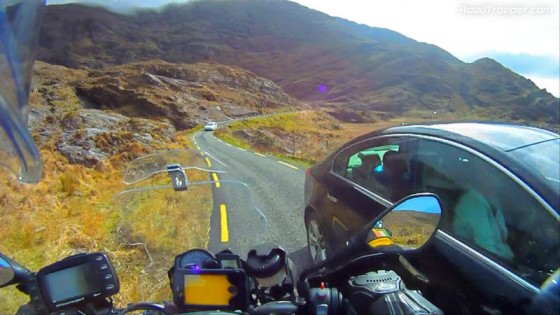
Near miss on a rural Irish road just after coming around a blind corner. I’d noticed the French driver driving far too fast from about half a mile down the road so I was ready for it. However he did not see me as he almost ran me off the road. You might say I had plenty of room except for the fact I had my big metal pannier boxes attached giving me less than an inch to clear his car. Notice the passenger turning away thinking we were going to crash! After this close call I swapped over to smaller soft panniers.
I should probably point out at this stage that this is a complicated subject with a glaring fact most motorcycle accidents have nothing to do with traffic. According to the latest edition of the Roadcraft Police Rider’s Handbook 65% of motorcycle accidents, injuries or fatalities happen on rural roads and do not involve any other vehicles. So the predominant cause here may be rider error or hazard factors typical of rural areas, wandering sheep, mud left on road from farm vehicles etc. I now typically ride on rural roads on Ireland’s west coast which in summer sees massive levels of tourist traffic, so looking at the highest dangers for a biker being traffic and rural roads, in theory Ireland’s west coast in summer is possibly one of the most dangerous places in Europe to be a biker!
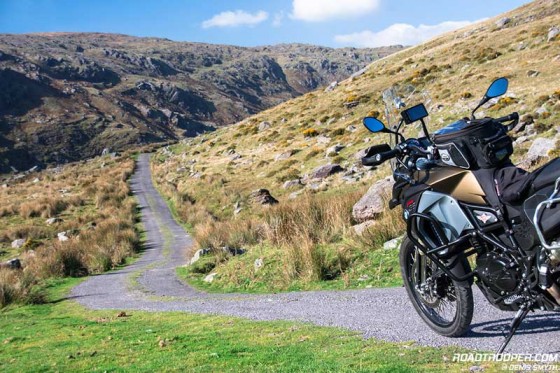
Kerry mountain boreen roads is where you’re likely to find me these days ![]() Almost no traffic but still little room for error..
Almost no traffic but still little room for error..
Today I’d like to think I have more skills and experience, but that is wiped out by the massively increased amount of fast moving furniture controled by the naturally increasing amount idiots that go along with good drivers. My skills “to a certain extent” don’t matter as more and more I find myself surrounded by other traffic and my life is quite literally dependent on the skills and attention of other drivers. Since moving back to Ireland I’ve signed up to RoSPA to continually increase/maintain my skill level and help lower the odds of an incident. Is there any proof that advanced training helps lower the odds? Yes, many insurance companies (professional gambling houses) offer up to a 30% discount on insurance for those with advanced driving skills simply because an advanced rider is statistically a lower risk.
Odds of Losing to a Fish!
A motorcyclist with 40 years accident free experience and a RoSPA Gold qualification may be considered an expert poker player who plays/rides to win. He/she is most likely to safely navigate rural roads for example as they are trained to constantly evaluate all possible dangers.
But here is the problem, while an advanced rider is possibly (based on insurance companies premiums) 30% less likely to have a single vehicle accident on a rural road, we still read stories of expert riders getting killed so what’s going on here? Very often the answer is fish! Yes you read right – fish! This is where we really get into my motorcycle/poker game theory.
The only way for a fish to become a pro is with experience/training, but during their time as a fish they can, and do wipe out a professionals bank due to their unpredictability. I hope no one takes offence to this but I view some drivers, both young and old as fish and it’s next to impossible, no matter how good a rider you are to 100% predict the actions of a fish. The proof of this is in how much insurance companies charge young drivers as insurance is gambling on a professional level. They run the odds based on statistics and place a bet – the insurance premium, the house always wins, as do the insurance companies.
We are all aware that even the best of riders get killed by a moment’s inattention of even a good driver having a bad day. In poker a fish will often beat a pro, in life bad driving can destroy the life of any other driver, advanced rider trained professional or other. My chances of meeting a bad driver on the road has nothing to do with bad luck, it’s the law of probability based on odds which is calculated with statistics.
Good luck is when you find a great advanced training instructor who gives you a price reduction and teaches you a calm frame of mind to deal with the insect splatter, to spot oil spills, defensive riding to avoid tailgaters and the likely areas where deers might jump out well in advance of it ever happening thus avoiding high risk situations in the first place.
This is where the element of chance comes into my motorbike/poker game theory. You really only have two choices here as experience, skill and the ability to manage to odds sometimes come to naught due to a fish. So either you stop playing and leave motorbikes, or you get advanced training to increase your odds of winning and buy the best armour you can afford and pray to God you’ll never need it, full stop!
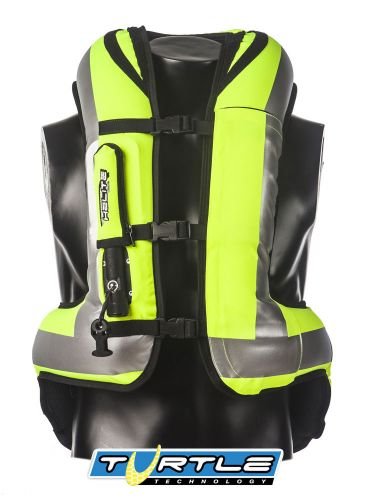
The Helite Airbag Vest. Originally these were designed for horse riders – a sport even more dangerous than motorcycling. Studies show a serious incident can be expected at the rate of 1 per 7,000 hours of motorcycle riding while serious injury rates exceeding 1 per 350 horse riding hours have been shown, making horseback riding 20 times more dangerous than motorcycling.
So the answer is yes, I will, as soon as I can afford, buy an air vest. I just hope it won’t have the same limitation of use as a helmet – 3 years!
Now, at this stage you are probably wondering how the hell this story went from FBoS training to fish and my motorcycle/poker game theory. Actually it never left. With increased traffic etc not only am I more likely to have an accident, I am also more likely to come upon a collision. With the amount of time I spend on the road there is an increasing likelihood that sooner or later I might unfortunately find a fellow biker in a bad way. I want to be able to help them, and maybe, just maybe it will be you, hence the FBoS training. And if it’s my turn to have a bad day or be bitten by a fish I can only hope that one of my fellow brother or sister FBoS trained bikers find me before anyone else.
For all those who think my bike/poker game theory is completely insane all I can say is just roll with it, I’ve never claimed to be normal, nor do I ever want to be ![]()
Lastly, for what it’s worth the First Bike on Scene gets the official RoadTrooper seal of approval for outstanding service to the motorcycle community.
More info on the FBoS Course
Who is the course for?
The First Bike on Scene course was originally developed by paramedics working in the North West Ambulance Service(UK) back in 2003/4. Due to the nature of their work and being bikers themselves, they realised the need for a medical emergency care course appropriate to the needs of injured motorcyclists. So in the unfortunate event of witnessing a motorcycle accident you will benefit from the emergency response skills and knowledge imparted on this course.By learning an appropriate strategy for dealing with an accident scene, it is our hope that it may give you the confidence to make a difference to some ones life.You need no previous training in first-aid to take part .
Is it certified?
Yes. Following a successful skills assessment, as laid out by the North West Ambulance Service, you will receive a certificate of competency. It is issued by the Quality Casualty Care Alliance, UK. Each certificate has a unique ID Number and is valid for 3 years.
The CPR / AED module is separately certified through the Irish Heart Foundation and successful candidates will receive the Heart Saver Adult CPR and AED certificate. However this course does not substitute an Occupational First Aid Course for the workplace as required by your employer under Health&Safety Legislation.
What will you learn?
- Safe Approach and Management of an Accident Scene
- Airway Management
- Injury Assessment
- Management of Head and Neck (c-spine) Injuries
- Control of Bleeding
- Recognition of Catastrophic Bleeding
- Safe Helmet Removal in Special Circumstances
- Log Roll
- Trauma CPR
- Irish Heart Foundation Adult CPR with Automated External Defibrillator
Should I be afraid of helping someone in case I’m sued?
This is a major issue in the UK and Ireland. In my time on the Isle of Man which you might think as being bike friendly I know of at least one occasion where an injured biker was left on the side of the road as cars drove past refusing to stop and help. On the flip side in countries like Spain it is a criminal offence not to stop and help and in Germany you must pass a First Aid course as part of your driving/riding licence exam.
In any country, including the UK and Ireland the Law takes a practical and sensible approach to this – any person, acting as non-professional rescuer, is only required to do what would be reasonably expected in view of their knowledge / skills / training. In other words, to act ‘in a reasonable manner’, to help a person in need. Members of the public are not required to have a first aid course behind them in order to render aid. Those with training and going to the aid of an ill or injured person need only remain within the remit of their training to be protected by the Law whatever the outcome of the event.
How much does the course cost?
The total cost for the course is €70 / £ 70 per person plus €10 / £10 for the certification. To secure a place on your chosen ‘First Bike on Scene’ Course, please forward FBoS the booking form and a €25 / £25 non-refundable deposit. The outstanding balance is due on the day of the course.
Check training dates and book here:
Bikers Training (Ireland)
First Biker on Scene (UK)
Accepted means of payment are cash, cheque, postal order, bank transfer or paypal.
FBoS offer group bookings to clubs or groups of friends. To avail of a group discount, you will need a minimum of 12 people attending. For further information please contact us on bookings [at] bikerstraining [dot] com or bookingsuk [at] bikerstraining [dot] co [dot] uk
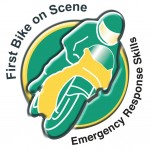
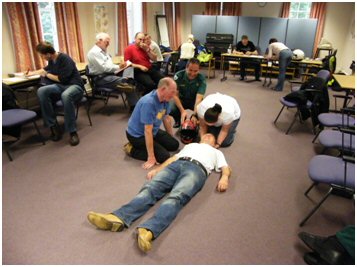
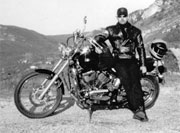







Just following up on few adaptations
Emergency care protocols change every three years or so with worldwide CPR-AED Being 5 yearly.
The current FBOS-ERS runs on 2016-17 updates and few changes to include : catastrophic blood loss assessment – use of scoop orthopedic stretcher and employment of Vacuum mattress. managing the drivers potential risk from car bike T-Bone impact.
2018 we launched the new approved FBOS Advanced we have rolled it out firstly with Shed4Bikers group and UK Unity Support Riders Team. It’s proving to be a natural progression for enthusiastic responders who want more knowledge skills and abilities
See. http://www.bikerstraining.com for more details
Rodge FBOSTeam